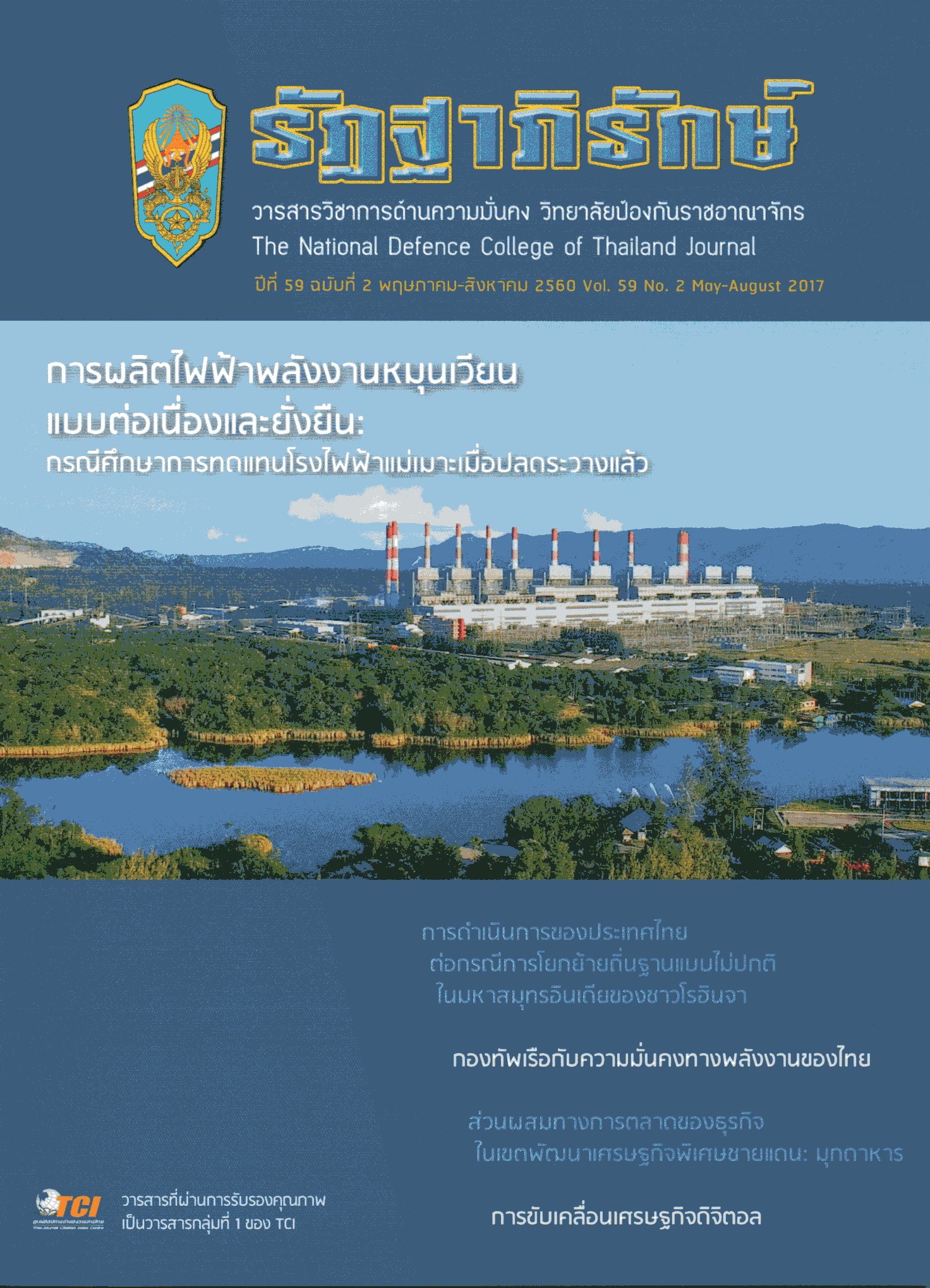การผลิตไฟฟ้าพลังงานหมุนเวียนแบบต่อเนื่องเเละยั่งยืน : กรณีศึกษาการทดเเทนโรงไฟฟ้าเเม่เมาะเมื่อปลดระวางแล้ว
คำสำคัญ:
พลังงานห, โรงไฟฟ้า, พลังงานทดแทนบทคัดย่อ
บทคัดย่อ
การวิจัยนี้มีวัตถุประสงค์เพื่อศึกษาการนำเทคโนโลยีระบบเก็บสะสมพลังงานมาใช้ในการส่งเสริมการผลิตไฟฟ้าจากพลังงานหมุนเวียนอย่างต่อเนื่องและยั่งยืน และนำเสนอกรณีศึกษาโรงไฟฟ้าพลังงานหมุนเวียนและระบบเก็บสะสมพลังงานเพื่อทดแทนโรงไฟฟ้าแม่เมาะ จ.ลำปาง เมื่อปลดระวางในปี พ.ศ. 2594 การวิจัยนี้เป็นการวิจัยเชิงคุณภาพ ดำเนินการโดยการบูรณาการข้อมูลจากการทบทวนวรรณกรรม ข้อมูลทุติยภูมิ องค์ความรู้ของผู้วิจัย และข้อมูลจากการสอบถามผู้เชี่ยวชาญเพื่อทำการวิเคราะห์และนำเสนอรูปแบบโรงไฟฟ้าพลังงานหมุนเวียน และระบบเก็บสะสมพลังงานทดแทนโรงไฟฟ้าแม่เมาะ รวมทั้งทำการวิเคราะห์ความคุ้มค่าเชิงเศรษฐศาสตร์ ความมั่นคงทางพลังงาน สิ่งแวดล้อม และสังคมของระบบดังกล่าว
จากการศึกษาพบว่าไฟฟ้าจากพลังงานหมุนเวียนประเภทแสงอาทิตย์และลมจัดเป็นไฟฟ้าพลังงานหมุนเวียนแบบแปรปรวน โดยมีปัญหาหลักคือไฟฟ้าที่ผลิตได้จากพลังงานดังกล่าวมักมีปริมาณไม่คงที่ ขึ้นอยู่กับสภาพอากาศในแต่ละช่วงเวลา จึงไม่สามารถควบคุมกำลังผลิตที่แน่นอนได้ แนวทางหนึ่งที่ช่วยแก้ปัญหาดังกล่าวคือ การนำระบบเก็บสะสมพลังงานมาใช้ สำรองไฟฟ้าที่ผลิตได้ในช่วงเวลาหนึ่งไว้นำไปใช้จ่ายไฟฟ้าในช่วงเวลาที่โรงไฟฟ้าพลังงานหมุนเวียน ไม่สามารถผลิตไฟฟ้าได้ ทั้งนี้ เนื่องจากประเทศไทยมีแผนส่งเสริมการเพิ่มกำลังผลิตไฟฟ้าจากพลังงานหมุนเวียนแปรปรวนให้สูงขึ้นในอนาคต จึงควรที่จะมีแผนสนับสนุนการพัฒนาระบบเก็บสะสมพลังงานเพื่อแก้ปัญหาดังกล่าว
สำหรับกรณีศึกษาในการวิจัยได้ศึกษาพบว่าบริเวณโรงไฟฟ้าและเหมืองแม่เมาะเมื่อปลดระวางในปี พ.ศ. 2594 มีศักยภาพในการพัฒนาเป็นโครงการโรงไฟฟ้าพลังงานแสงอาทิตย์ขนาด 1,500 เมกะวัตต์ และระบบเก็บสะสมพลังงานแบบสูบกลับขนาด 1,000 เมกะวัตต์ ซึ่งระบบสูบกลับนี้จะช่วยลดปัญหาความแปรปรวนทำให้โครงการสามารถผลิตไฟฟ้าได้อย่างต่อเนื่อง โดย เงินลงทุนของโครงการรวมทั้งสิ้น 82,000 ล้านบาท อัตราตอบแทนการลงทุนโครงการ 12.29% ช่วยลดปริมาณการปล่อยก๊าซเรือนกระจกได้ 1.03 ล้านตันต่อปี เหมาะสมที่จะพัฒนาเป็นโครงการต้นแบบการผลิตไฟฟ้าพลังงานหมุนเวียน 100% ขนาดใหญ่แห่งแรกของประเทศไทย
Abstract
The objectives of this research are to study applications of energy storage systems for enhancing non-intermittency and sustainability in renewable energy generation as well as to propose plan for developing renewable power plant and energy storage system for substitution of Mae Moh Power Plant in Lampang Province of Thailand after its retirement in 2051. This research was conducted in a qualitative approach by gathering information from various sources including literature review, secondary data collection, experiences of researcher and experts. Subsequently, gathered information was analyzed to define configurations of the renewable power plant and energy storage system as well as analyzed on economic feasibility, energy security, environment and social benefits.
The main problem focused in this research is that power generated from renewable energy resources such as solar and wind are intermittent and varying. Amounts of power generated from these energy sources depend strongly on weather conditions. As a result, it is impossible to control amounts of power generated from intermittent renewable energy and balance with amounts of power required by load at any time. One promising solution to tackle this problem is to store power generated at one time in energy storage systems and uses it at another time when renewable energy cannot be generated.
The problem of intermittency of renewable energy is the main impediment of increasing penetration of renewable energy in Thailand grid system in the near future. It is, therefore, necessary that the country shall execute energy storage development plan as soon as possible to mitigate any difficulties related to this problem.
According to the research, after the retirement of Mae Moh Power Plant and Mine, areas of the power plant and mine is highly recommended to be developed to the System of 1,500-megawatt Solar Power Plant and 1,000-megawatt Pumped Hydro Storage. The Pumped Hydro Storage in the System could serve as an energy storage that charges energy from the solar power plant during the day and discharges energy during the night when the solar power plant cannot generate electricity and power demand is relatively high. Capital investment of the System is estimated to be around 82,000 million THB. Project internal rate of return (PIRR) is as high as 12.29%. In addition, the System could help to reduce emission at the rate of 1.03 million tons of carbon dioxide equivalent per year compared to convention electricity generation from fossil fuels. Due to the aforementioned reasons, this System has the potential to be the model of 100% renewable energy generation, able to generate non-intermittent and sustainable power in the Gigawatt range.
ดาวน์โหลด
เผยแพร่แล้ว
ฉบับ
ประเภทบทความ
สัญญาอนุญาต
บทความ ข้อเขียน หรือความคิดเห็นในนิตยสารนี้เป็นของผู้เขียน ไม่ผูกพันกับวิทยาลัย ป้องกันราชอาณาจักรและทางราชการแต่อย่างใด



